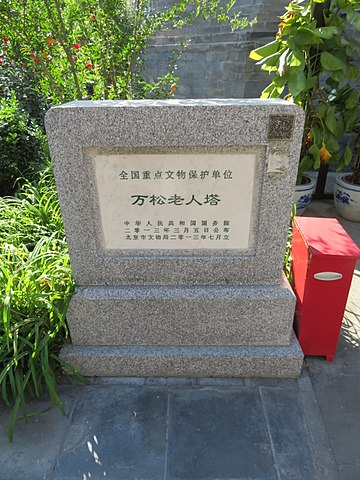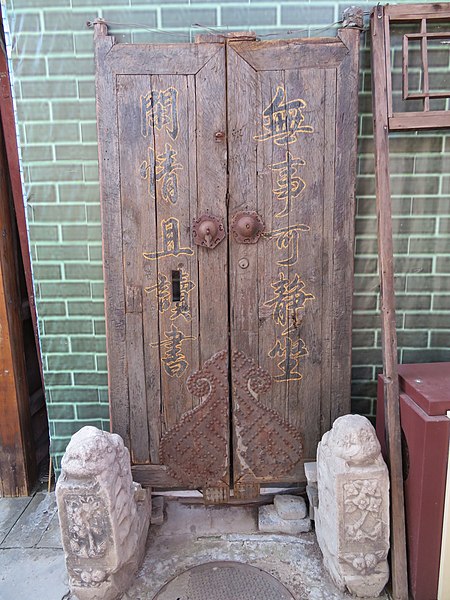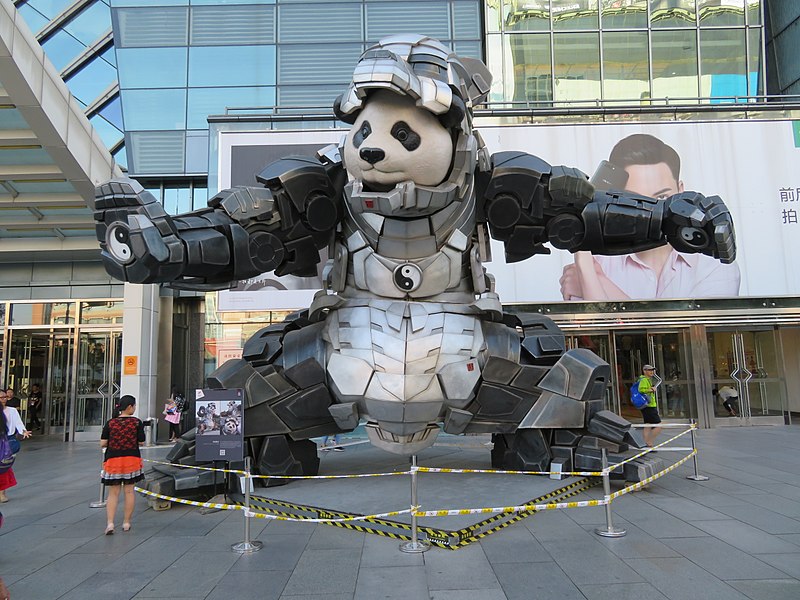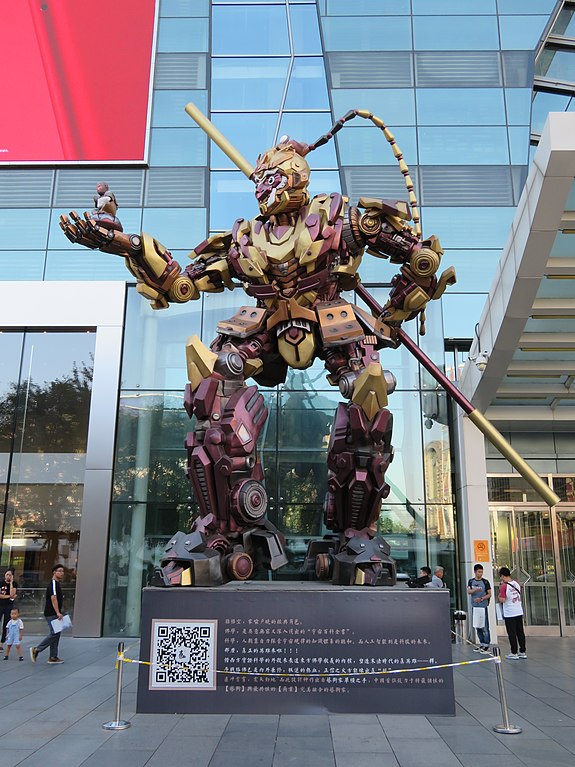Diary of a Rambling Antiquarian
Monday, 18 September 2017
Wansong Laoren Pagoda
After this morning's excursion to the Haotian Pagoda in the Fangshan District I decide to walk from my hotel near Wangfujing to a small and little-known octagonal brick pagoda near Xisi, about an hour away (although it ends up taking longer as I once again stray from Google's suggested route). This is the sepulchral pagoda for the Chan Buddhist monk Wansong Xingxiu 萬松行秀 (1166–1246), also known as the Old Man of Ten Thousand Pines (Wànsōng Lǎorén 萬松老人), who lived during the time of transition and conflict between the Jin dynasty and Mongol Empire.
The Pagoda of the Old Man of Ten Thousand Pines (Wànsōng Lǎorén Tǎ 萬松老人塔) stands in a courtyard immediately south of Brick Pagoda Alley (Zhuāntǎ Hútóng 磚塔胡同), as can be seen in the Late Qing and Republican Period maps shown below.
Detail of a Late Qing Map of Beijing showing Wansong Laoren Pagoda
From a reprint of a Late Qing map entitled "Complete Map of the Inner and Outer Districts of the Capital City" (Jīngchéng nèiwài shǒushàn quántú 京城内外首善全圖) printed and sold by the Zhengyang Shuju 正陽書局 bookshop located in the pagoda courtyard.
The pagoda is marked with a 🛔 symbol between Mutton Alley (Yángròu Hútóng 羊肉胡同) and Brick Pagoda Alley (Zhuāntǎ Hútóng 磚塔胡同), although in fact it fills the space immediately south of Brick Pagoda Alley. Click on the image to show the whole north-west corner of the map.
Detail of a Republican period Map of Beiping showing Wansong Laoren Pagoda
From a reprint of a Republican period map entitled "Detailed Map of the Inner and Outer Districts of Beiping" (Běipíng nèiwàichéng xiángtú 北平内外城詳圖) printed and sold by the Zhengyang Shuju 正陽書局 bookshop located in the pagoda courtyard.
The pagoda is marked with a 🛔 symbol, and the pagoda courtyard is shaded in orange. The pagoda is labelled as the "Yuan dynasty Pagoda of Wansong Laoren" (Yuán Wànsōng Lǎorén Tǎ 元萬松老人塔). Click on the image to show the surrounding area.
The geography of the area has changed little over the centuries, but during the second half of the 20th century shops and houses were built up around the pagoda, with the result that it was inaccessible and largely obscured from the outside until quite recently. The pagoda was restored in 1986, and then again during the construction of the Xisi subway station in 2009, but it has only been open to the public since the courtyard was renovated in 2013–2014 and dedicated as a public space by the local Xicheng District government.
The pagoda is located just south of Brick Pagoda Alley (as it has always been), with an unassuming entrance (no entrance fee or doorkeeper) facing onto Xisi Street. From the hustle and bustle of Xisi, I stepped over the threshold of the gate and entered into another world and another age — an unexpected oasis of greenery and tranquillity in the heart of modern Beijing. The pagoda is surrounded on all sides by roses and pomegranate trees, in a small courtyard with bookshops specializing in the history of Beijing on the north and the south sides. Quite the most pleasant place I have ever found within Beijing city.
Pedestal Tablet in front of Wansong Laoren Pagoda
Wansong Laoren Pagoda from the South-East
Wansong Laoren Pagoda from the West
After the death of Monk Wansong in 1246, his disciples erected a brick pagoda to house his remains in the western outskirts of the former Central Capital of the Jin dynasty (at that time called Yanjing 燕京). After several centuries the pagoda fell into disrepair and it became lost in the busy streets of the bourgeoning city of Beijing. In 1606, during the late Ming dynasty, a monk called Le'an (樂庵) raised money to repair the dilapidated pagoda. But it is not this pagoda that stands here today.
The nine-storeyed octagonal brick pagoda pagoda which we see now dates to the mid Qing dynasty. It was constructed by order of the Qianlong Emperor in 1753 under the direction of the Prince Kang (Aisin Gioro Yong'en 愛新覺羅・永恩). The original 13th-century pagoda was not demolished, but instead the new pagoda was built around the original pagoda, entirely encasing it. At 15.9 metres in height it is about three times as high as the original pagoda.
South Face of the Wansong Laoren Pagoda
Above the faux door is an inscription commemorating the restoration of the pagoda in Qianlong 18 [1753] by Prince Kang on the order of the Qianlong Emperor (乾隆十八年岁次癸酉七月榖旦康亲王臣永恩奉勅重脩).
During renovations in 1986 the original brick pagoda was discovered to be still intact inside the pagoda. This original pagoda is octagonal in shape, seven-storeyed, and about 5 metres in height, but with a flat top ( the original finial had presumably been lost by the time the new pagoda was built). On the front is a stone plaque engraved with the words "Pagoda of the Old Man of Ten Thousand Pines" (萬松老人塔). The original pagoda is now invisible, hidden inside the 18th-century brickwork.
There is a small exhibition room on the north side of the courtyard, next to one of the bookstores, and in it are a few artefacts dating from the Yuan dynasty to the Republican period, including this lovely example of a grey pottery sculpture of a Kalaviṅka (Chinese 妙音鳥 "beautiful-sounding bird"), unfortunately missing its head. It dates to the Yuan dynasty, and was found at Dafangjia Hutong (大方家胡同) in Beijing, which was part of the Huanghua Quarter (皇華坊) of the Yuan capital of Dadu. Kalaviṅka sculptures like this one are a particular feature of Tangut art, and as there were many Tangut Buddhist monks in the Yuan capital this sculpture may have been part of a Tangut Buddhist temple.
Yuan dynasty grey pottery sculpture of a Kalaviṅka
On the west side of the courtyard are some modern decorative pieces, including a couplet written on a door by local artist Lao Wu 老伍 (pen name of Wu Peixian 伍佩銜) in 2015. I buy a signed set of eighteen door couplet drawings by Lao Wu from the bookstore, along with a set of Beijing maps. I had inadvertently left my reading glasses back in my hotel room, and so unable to read any of the books on Beijing history on the bookstore shelves, for once I leave a bookstore without buying any books.
Decorative board at the West side of the Pagoda Courtyard
Door couplet by Lao Wu
無事可靜坐,閑情且讀書
If you have nothing to do you can sit quietly, if you are feeling idle then read a book
When I finally leave the comfort of the pagoda courtyard, I walk south along Xisi Street to the underground station at Xidan. On the way I pass by two giant sculptures by Bi Heng 毕横 which seem somehow to be a fitting conclusion to a good first day in China.
Sculpture of A Panda by Bi Heng
"A Panda" 阿潘达
Sculpture of Sun Wukong by Bi Heng
"Sun Wukong defeats Buddha in battle" 斗战胜佛孙悟空
Beijing | Pagodas | Tombs | Yuan dynasty
Index of Rambling Antiquarian Blog Posts
Rambling Antiquarian on Google Maps










